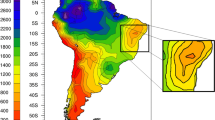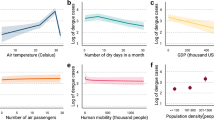Abstract
Dengue fever is a mosquito-borne virus that infects 50–100 million people each year1. Of these infections, 200,000–500,000 occur as the severe, life-threatening form of the disease, dengue haemorrhagic fever (DHF)2. Large, unanticipated epidemics of DHF often overwhelm health systems3. An understanding of the spatial–temporal pattern of DHF incidence would aid the allocation of resources to combat these epidemics. Here we examine the spatial–temporal dynamics of DHF incidence in a data set describing 850,000 infections occurring in 72 provinces of Thailand during the period 1983 to 1997. We use the method of empirical mode decomposition4 to show the existence of a spatial–temporal travelling wave in the incidence of DHF. We observe this wave in a three-year periodic component of variance, which is thought to reflect host–pathogen population dynamics5,6. The wave emanates from Bangkok, the largest city in Thailand, moving radially at a speed of 148 km per month. This finding provides an important starting point for detecting and characterizing the key processes that contribute to the spatial–temporal dynamics of DHF in Thailand.
This is a preview of subscription content, access via your institution
Access options
Subscribe to this journal
Receive 51 print issues and online access
$199.00 per year
only $3.90 per issue
Buy this article
- Purchase on Springer Link
- Instant access to full article PDF
Prices may be subject to local taxes which are calculated during checkout





Similar content being viewed by others
References
Gubler, D. J. Dengue and dengue hemorrhagic fever. Clin. Microbiol. Rev. 11, 480–496 (1998)
Gubler, D. J. The global pandemic of dengue/dengue haemorrhagic fever: current status and prospects for the future. Ann. Acad. Med. Singapore 27, 227–234 (1998)
DeRoeck, D., Deen, J. & Clemens, J. D. Policymakers' views on dengue fever/dengue haemorrhagic fever and the need for dengue vaccines in four southeast Asian countries. Vaccine 22, 121–129 (2003)
Huang, N. E. et al. The empirical mode decomposition and the Hilbert spectrum for nonlinear and non-stationary time series analysis. Proc. R. Soc. Lond. A 454, 903–995 (1998)
Ferguson, N., Anderson, R. & Gupta, S. The effect of antibody-dependent enhancement on the transmission dynamics and persistence of multiple-strain pathogens. Proc. Natl Acad. Sci. USA 96, 790–794 (1999)
Hay, S. I. et al. Etiology of interepidemic periods of mosquito-borne disease. Proc. Natl Acad. Sci. USA 97, 9335–9339 (2000)
Chareonsook, O., Foy, H. M., Teeraratkul, A. & Silarug, N. Changing epidemiology of dengue hemorrhagic fever in Thailand. Epidemiol. Infect. 122, 161–166 (1999)
Watts, D. M., Burke, D. S., Harrison, B. A., Whitmire, R. E. & Nisalak, A. Effect of temperature on the vector efficiency of Aedes aegypti for dengue 2 virus. Am. J. Trop. Med. Hyg. 36, 143–152 (1987)
Tun-Lin, W., Burkot, T. R. & Kay, B. H. Effects of temperature and larval diet on development rates and survival of the dengue vector Aedes aegypti in north Queensland, Australia. Med. Vet. Entomol. 14, 31–37 (2000)
Gubler, D. J. & Rosen, L. Quantitative aspects of replication of dengue viruses in Aedes albopictus (Diptera: Culicidae) after oral and parenteral infection. J. Med. Entomol. 13, 469–472 (1977)
Rosen, L., Roseboom, L. E., Gubler, D. J., Lien, J. C. & Chaniotis, B. N. Comparative susceptibility of mosquito species and strains to oral and parenteral infection with dengue and Japanese encephalitis viruses. Am. J. Trop. Med. Hyg. 34, 603–615 (1985)
Grenfell, B. T., Bjornstad, O. N. & Kappey, J. Travelling waves and spatial hierarchies in measles epidemics. Nature 414, 716–723 (2001)
Bjornstad, O. N., Peltonen, M., Liebhold, A. M. & Baltensweiler, W. Waves of larch budmoth outbreaks in the European alps. Science 298, 1020–1023 (2002)
Bacon, P. J. Population Dynamics of Rabies in Wildlife (Academic, London, 1985)
Sherratt, J. A. Periodic travelling waves in cyclic predator–prey systems. Ecol. Lett. 4, 30–37 (2001)
Mollison, D. Modeling biological invasions—chance, explanation, prediction. Phil. Trans. R. Soc. Lond. B 314, 675–693 (1986)
Bjornstad, O. N., Ims, R. A. & Lambin, X. Spatial population dynamics: analyzing patterns and processes of population synchrony. Trends Ecol. Evol. 14, 427–432 (1999)
Bjornstad, O. N. & Falck, W. Nonparametric spatial covariance functions: estimation and testing. Environ. Ecol. Stat. 8, 53–70 (2001)
Lambin, X., Elston, D. A., Petty, S. J. & MacKinnon, J. L. Spatial asynchrony and periodic travelling waves in cyclic populations of field voles. Proc. R. Soc. Lond. B 265, 1491–1496 (1998)
de Roos, A. M., McCauley, E. & Wilson, W. G. Pattern formation and the spatial scale of interaction between predators and their prey. Theor. Popul. Biol. 53, 108–130 (1998)
Coulson, T. et al. Age, sex, density, winter weather, and population crashes in Soay sheep. Science 292, 1528–1531 (2001)
Nisalak, A. et al. Serotype-specific dengue virus circulation and dengue disease in Bangkok, Thailand from 1973 to 1999. Am. J. Trop. Med. Hyg. 68, 191–202 (2003)
Gubler, D. J. et al. Virological surveillance for dengue hemorrhagic-fever in Indonesia using the mosquito inoculation technique. Bull. WHO 57, 931–936 (1979)
Anderson, R. M., Grenfell, B. T. & May, R. M. Oscillatory fluctuations in the incidence of infectious disease and the impact of vaccination: time series analysis. J. Hyg. (Lond.) 93, 587–608 (1984)
Acknowledgements
We thank O. Bjornstad for making R code available.This work was supported by grants from the National Oceanic and Atmospheric Administration's Joint Program on Climate Variability and Human Health (a consortium including the EPA, NASA, NSF and EPRI), and the Bill and Melinda Gates Foundation.
Author information
Authors and Affiliations
Corresponding author
Ethics declarations
Competing interests
The authors declare that they have no competing financial interests.
Supplementary information
41586_2004_BFnature02225_MOESM1_ESM.jpg
Supplementary Figure 1: Spatial phase coherence function of three-year mode of variance in DHF Incidence in Thailand. (JPG 22 kb)
41586_2004_BFnature02225_MOESM2_ESM.jpg
Supplementary Figure 2: Lags of Maximum Correlation (of CCF from Figure 5 in text) as a function of distance from Bangkok. (JPG 45 kb)
Rights and permissions
About this article
Cite this article
Cummings, D., Irizarry, R., Huang, N. et al. Travelling waves in the occurrence of dengue haemorrhagic fever in Thailand. Nature 427, 344–347 (2004). https://doi.org/10.1038/nature02225
Received:
Accepted:
Issue Date:
DOI: https://doi.org/10.1038/nature02225
This article is cited by
-
Minimum wave speed for dengue prevalence in the symptomatic and asymptomatic infected individuals
Computational and Applied Mathematics (2023)
-
Assessing the impact of human mobility to predict regional excess death in Ecuador
Scientific Reports (2022)
-
Determine neighboring region spatial effect on dengue cases using ensemble ARIMA models
Scientific Reports (2021)
-
Incorporating human mobility data improves forecasts of Dengue fever in Thailand
Scientific Reports (2021)
-
Numerical analysis for iterative filtering with new efficient implementations based on FFT
Numerische Mathematik (2021)
Comments
By submitting a comment you agree to abide by our Terms and Community Guidelines. If you find something abusive or that does not comply with our terms or guidelines please flag it as inappropriate.



